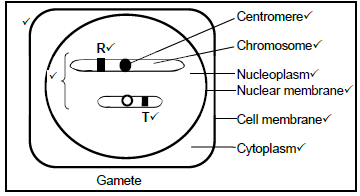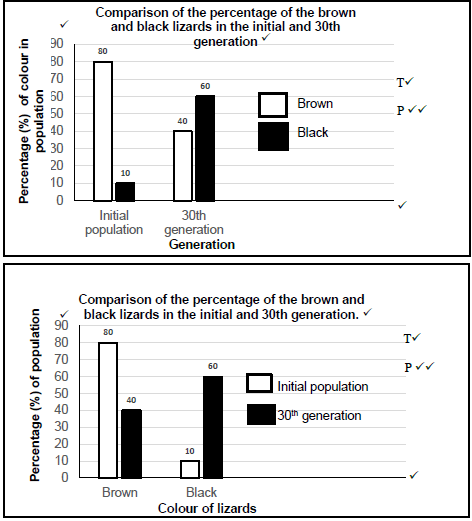LIFE SCIENCES PAPER 2 GRADE 12 MEMORANDUM - NSC PAST PAPERS AND MEMOS NOVEMBER 2016
Share via Whatsapp Join our WhatsApp Group Join our Telegram GroupLIFE SCIENCES PAPER 2
GRADE 12
MEMORANDUM
NATIONAL SENIOR CERTIFICATE
NOVEMBER 2016
PRINCIPLES RELATED TO MARKING LIFE SCIENCES
- If more information than marks allocated is given
Stop marking when maximum marks is reached and put a wavy line and 'max' in the right-hand margin. - If, for example, three reasons are required and five are given
Mark the first three irrespective of whether all or some are correct/incorrect. - If whole process is given when only a part of it is required
Read all and credit the relevant part. - If comparisons are asked for, but descriptions are given
Accept if the differences/similarities are clear. - If tabulation is required, but paragraphs are given
Candidates will lose marks for not tabulating. - If diagrams are given with annotations when descriptions are required
Candidates will lose marks. - If flow charts are given instead of descriptions
Candidates will lose marks. - If sequence is muddled and links do not make sense
Where sequence and links are correct, credit. Where sequence and links are incorrect, do not credit. If sequence and links become correct again, resume credit. - Non-recognised abbreviations
Accept if first defined in answer. If not defined, do not credit the unrecognised abbreviation, but credit the rest of the answer if correct. - Wrong numbering
If answer fits into the correct sequence of questions, but the wrong number is given, it is acceptable. - If language used changes the intended meaning
Do not accept. - Spelling errors
If recognisable, accept the answer, provided it does not mean something else in Life Sciences or if it is out of context. - If common names are given in terminology
Accept, provided it was accepted at the national memo discussion meeting. - If only the letter is asked for, but only the name is given (and vice versa)
Do not credit. - If units are not given in measurements
Candidates will lose marks. Memorandum will allocate marks for units separately. - Be sensitive to the sense of an answer, which may be stated in a different way.
- Caption
All illustrations (diagrams, graphs, tables, etc.) must have a caption. - Code-switching of official languages (terms and concepts)
A single word or two that appear(s) in any official language other than the learner's assessment language used to the greatest extent in his/her answers should be credited, if it is correct. A marker that is proficient in the relevant official language should be consulted. This is applicable to all official languages. - Changes to the memorandum
No changes must be made to the memoranda. The provincial internal moderator must be consulted, who in turn will consult with the national internal moderator (and the Umalusi moderators where necessary). - Official memoranda
Only memoranda bearing the signatures of the national internal moderator and the Umalusi moderators and distributed by the National Department of Basic Education via the provinces must be used.
SECTION A
QUESTION 1
1.1
1.1.1 D✓✓
1.1.2 C✓✓
1.1.3 C✓✓
1.1.4 C✓✓
1.1.5 C✓✓
1.1.6 No correct answer
1.1.7 B✓✓
1.1.8 D✓✓
1.1.9 A✓✓
(8 x 2)(16)
1.2
1.2.1 Ribosome✓
1.2.2 Peptide✓
1.2.3 Replication✓
1.2.4 Non-disjunction✓
1.2.5 Extinction✓
1.2.6 Hypothesis✓
1.2.7 tRNA✓/transfer RNA
(7 x 1)(7)
1.3
1.3.1 B only✓✓
1.3.2 B only✓✓
1.3.3 A only✓✓
(3 x 2)(6)
1.4
1.4.1
- Adenine✓/A(1)
- Deoxyribose✓sugar(1)
- Hydrogen bond✓(1)
1.4.2 10✓(1)
1.4.3 DNA has the nitrogen base thymine✓
whereas RNA has the nitrogen base uracil✓ (Mark first ONE only)(2) (6)
1.5
1.5.1
- Homologous chromosomes✓/Bivalent(1)
- Centromere✓(1)
- Chromatid✓(1)
1.5.2
- It holds the (two) chromatids together✓
- Attaches the chromosome to the spindle fibres✓ Any(1)
1.5.3
- Crossing over✓(1)
- Prophase 1✓(1)
1.5.4 Introduces variation✓/different gametes (1) (7)
1.6
1.6.1
- Hyracotherium✓(1)
- Sinohippus✓(1)
1.6.2 44✓mya✓(44 – 44,5)(2)
1.6.3 55✓/50 /46 million years✓/my(2) (6)
TOTAL SECTION A:48
QUESTION 2
2.1
2.1.1
- GgTt✓(1)
- Yellow✓ leaves no thorns✓(2)
2.1.2
GGtt✓
Ggtt✓
ggTT✓
ggTt✓
(Mark first FOUR only)(4) (7)
2.2
2.2.1 Human somatic cells have 23 pairs✓/46 chromosomes and this cell has only 2 pairs✓/4 chromosomes(2)
2.2.2
- 2✓(1)
- 2✓(1)
2.2.3

Criteria to mark diagram
| Single cell is drawn | 1 |
| Only 2 unreplicated chromosomes in drawing | 1 |
| Short unreplicated chromosome indicating T | 1 |
| Long unreplicated chromosome indicating R | 1 |
| Any ONE correct label | 1 |
(5) (9)
2.3
- The pair of alleles✓on homologous chromosomes separate
- during meiosis✓/anaphase/ gamete formation, so that
- only one allele of each pair is present in the gamete✓/ offspring can acquire one allele from each parent (3)
2.4
2.4.1
- Suffers from Huntington's✓chorea(1)
- hh✓(1)
2.4.2 hh✓(1)
2.4.3
- Emma's genotype is Hh✓/heterozygous
- The father's genotype has to be hh✓/homozygous recessive
- a cross between only these two genotypes✓/(Hh and hh) will ensure that there is 50% chance of the child not inheriting the disease
- The child inherits one recessive allele from each parent✓ (3) (6)
2.5.1 Transcription✓(1)
2.5.2 Nucleus✓/nucleoplasm(1)
2.5.3
- GTC✓(1)
- UAC✓(1)
2.5.4 Valine✓(2)
2.5.5
- A mutation affects the nucleotide sequence✓/nitrogen base sequence/gene structure
- Resulting in a changed mRNA✓/codon
- A different amino acid✓ may be coded for
- by tRNA✓/anticodon Any 3(3) (9)
2.6
2.6.1
P1 Phenotype Pink x Pink✓
Genotype RW x RW✓
Meiosis
P1 and F1✓
Meiosis and fertilisation✓ Any 6
OR
P1 Phenotype Pink x Pink ✓
Genotype RW x RW ✓
Meiosis
Fertilisation
| Gametes | R | W |
| R | RR | RW |
| W | RW | WW |
| 1 mark for correct gametes 1 mark for correct genotypes | ||
F1 Phenotype Red : Pink : White ✓
P1 and F1✓
Meiosis and fertilisation✓
Any 6 (6)
[40]
QUESTION 3
3.1
3.1.1 With the discovery that the soil bacterium Agrobacterium could be used to transfer useful genes from unrelated species into plants✓(1)
3.1.2
- Modified crops may become super-weeds✓/accidently breed with other plants to become super-weeds
- They are difficult/expensive to kill✓
- and could outcompete the original crop✓/other crops Any(2)
3.1.3
- Toxic proteins might be produced✓
- Antibiotic-resistance genes may be transferred to human gut bacteria✓
(Mark fist TWO only)(2) (5)
3.2
3.2.1 (a) colour of lizard✓(1)
3.2.2 (b) survival rate of the lizards✓(1)
- it decreases survival✓/lizards may die/is harmful/is lethal to the red lizards as
- they will be seen✓ on the black rock by the predators
OR
- They could not escape predators✓/catch prey on cold days
- as red lizards did not warm up fast on cold days✓ Any 1 x 2(2)
3.2.3 To allow enough time for reproduction✓ and survival to be able to calculate the percentage to ensure reliability✓ of results
OR
A change in population proportions will not be seen over a shorter time period✓ to ensure reliability✓ of results
Any 1 x 2(2)
3.2.4
- Conduct the investigation in the same habitat✓/environment
- Use the same sampling technique✓
- Capture the same number of lizards in each sampled generation ✓
- Take each sample at the same time of day✓/weather conditions
(Mark first TWO only) Any 2(2)
3.2.5
- There is variation✓in colour amongst the lizards
- *Red and brown✓lizards
- *are not camouflaged✓/cannot warm up fast enough to have energy to run away
- are killed by predators✓
- *The black lizards✓
- *are better camouflaged✓/warm up faster to have energy to avoid predators
- and survive✓/reproduce
- The allele for black colour is passed on to the next generation✓
- to produce more black lizards✓ in the next generation
Any 2+*4 compulsory marks(6)
3.2.6

Guideline for the assessing the graph
| Bar graph for the required data | 1 |
| Title of graph | 1 |
| Correct label and scale for X-axis | 1 |
| Correct label and scale for Y-axis | 1 |
| Drawing of bars | 1:1 to 3 bars plotted correctly 2:All 4 bars plotted correctly |
(6)
NOTE:
If the wrong type of graph is drawn, marks will be lost for:
- 'Bar graph'
- 'Drawing of bars'
If two graphs are drawn mark the first ONE only (20)
3.3
- The common ancestor✓/original camel population
- was separated✓ into different populations
- *by the sea✓/due to continental drift
- There was no gene flow✓between the populations
- Each population was exposed to different environmental conditions✓/selection pressures
- Natural selection occurred independently✓ in each population
- The individuals of each population became different✓ from each other over time
- genotypically and phenotypically✓
- Even if the three populations were to mix again✓
- they would not be able to interbreed✓
Any 5+*1 compulsory mark (6)
3.4
3.4.1 IA✓, IB✓, i✓(3)
3.4.2 2✓(1)
3.4.3
- Any individual inherits one allele✓(2)
- from each parent✓
3.4.4
- Each child✓
- has an equal✓/25% chance of having
- any blood group✓/ A, B, AB, or O.(3)(9)
[40]
SECTION C
QUESTION 4
HYPOTHESIS
- All modern humans✓*/Homo sapiens
- originated in Africa✓*
- and migrated to other parts✓ of the world 2(*compulsory) +1 (3)
FOSSIL EVIDENCE✓
- Fossils of Ardipithecus were found ONLY in Africa✓/Rift Valley/Ethiopia/South Africa
- Fossils of Australopithecus were found ONLY in Africa✓/Rift Valley/Ethiopia/South Africa
- The fossils of Homo habilis were ONLY found in Africa✓
- The OLDEST fossils of Homo erectus were found in Africa✓
- The OLDEST fossils of Homo sapiens were found in Africa✓ Max (4)
GENETIC EVIDENCE✓
- Mitochondrial DNA✓
- Is inherited only from the maternal line✓
- Analysis of mutations ✓ on this mitochondrial DNA
- shows that the oldest female ancestor were located in Africa✓
- And that all humans descended from her✓/mitochondrial Eve
- The Y chromosome shows the paternal line✓ Max (4)
CULTURAL EVIDENCE✓
- The OLDEST/most primitive artefacts (tools, cutlery, art etc.)
- were found in Africa✓ (2)
TOTAL FOR EVIDENCE(8)
BIPEDALISM
The fossils of all three genera indicate that:
- The foramen magnum✓
- is located in a more forward position✓
- The pelvis✓
- is wider and shorter✓
- The spine✓
- is S-shaped✓(6)
Content(17)
Synthesis(3)
(20)
ASSESSING THE PRESENTATION OF THE ESSAY
| Criterion | Relevance (R) | Logical sequence (L) | Comprehensive (C) |
| Generally | All information provided is relevant to the question. | Ideas are arranged in a logical sequence. | All aspects of the essay have been sufficiently addressed. |
| In this essay in Q4 | Only information relevant to the 'Out of Africa' hypothesis and bipedal fossils of the three genera are described. No irrelevant information included. | The description of the evidence for the 'Out of Africa' hypothesis and the evidence of bipedalism is presented in a logical and sequential manner. | At least the following marks should be obtained: - 7/11 for the 'Out of Africa' hypothesis and the evidence - 4/6 on evidence for bipedalism. |
| Mark | 1 | 1 | 1 |
TOTAL SECTION C: 20
GRAND TOTAL: 150